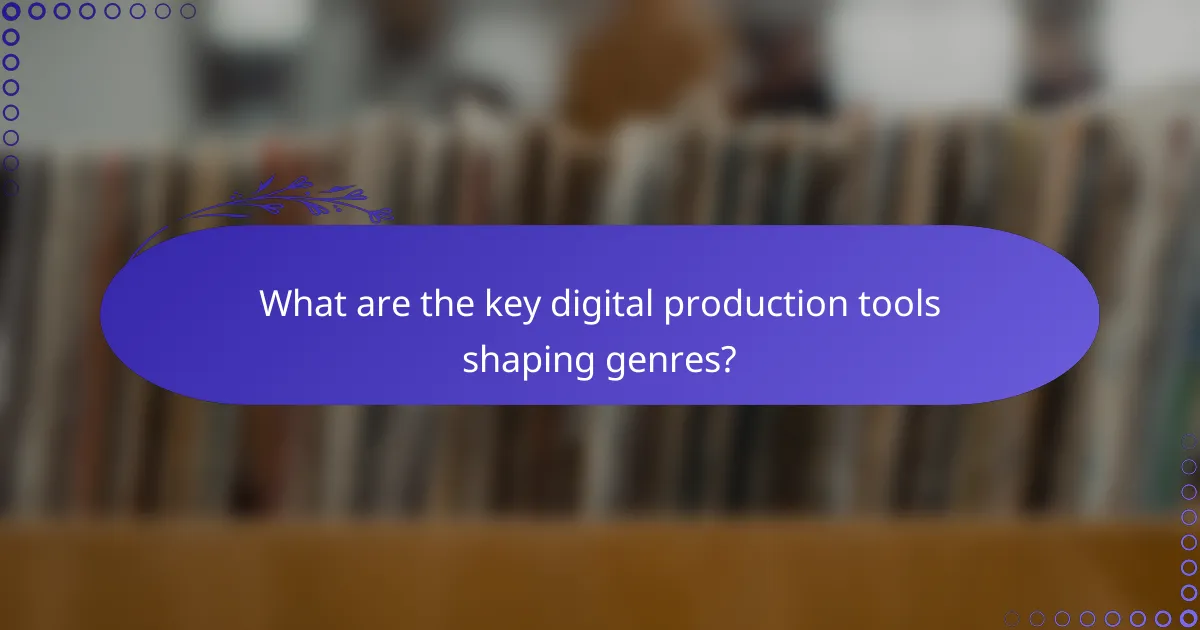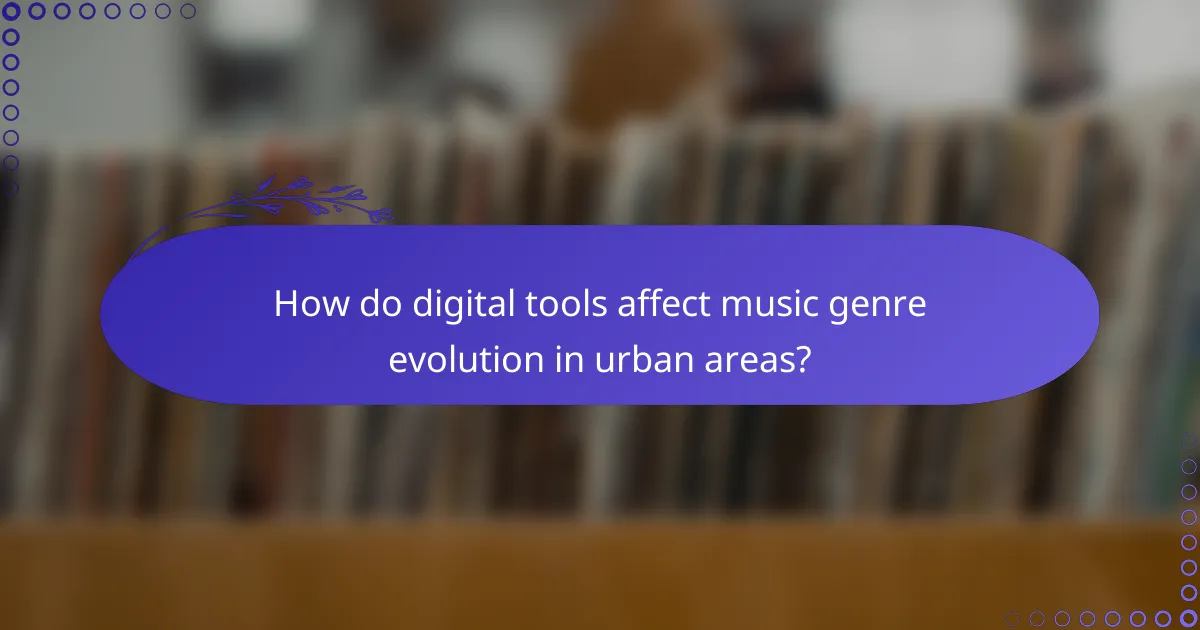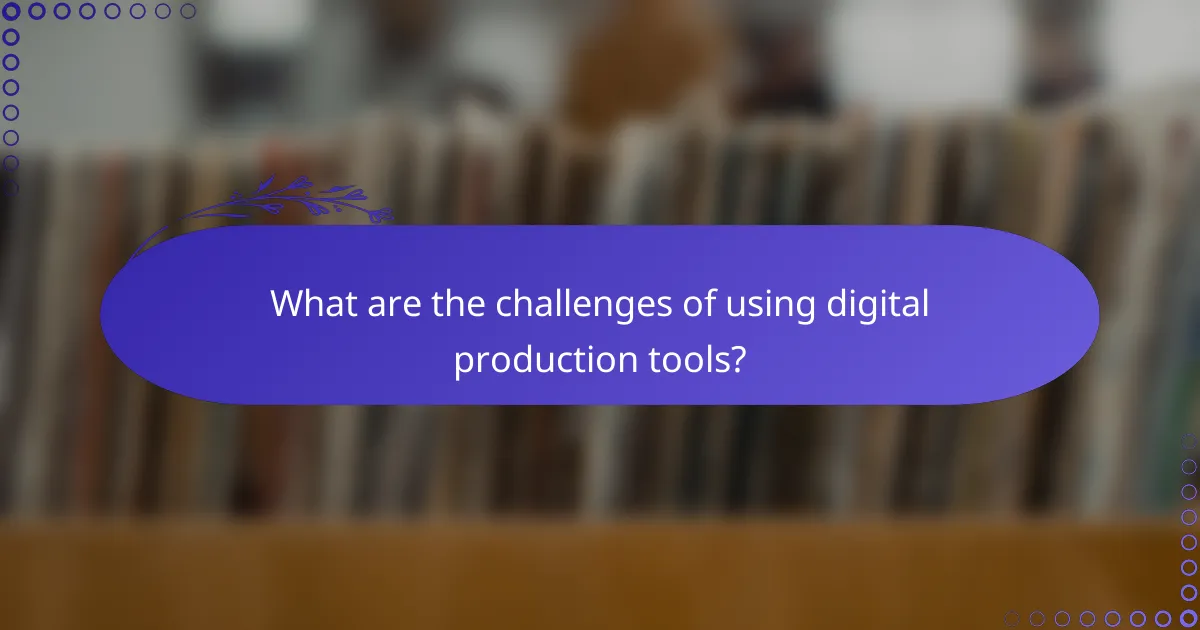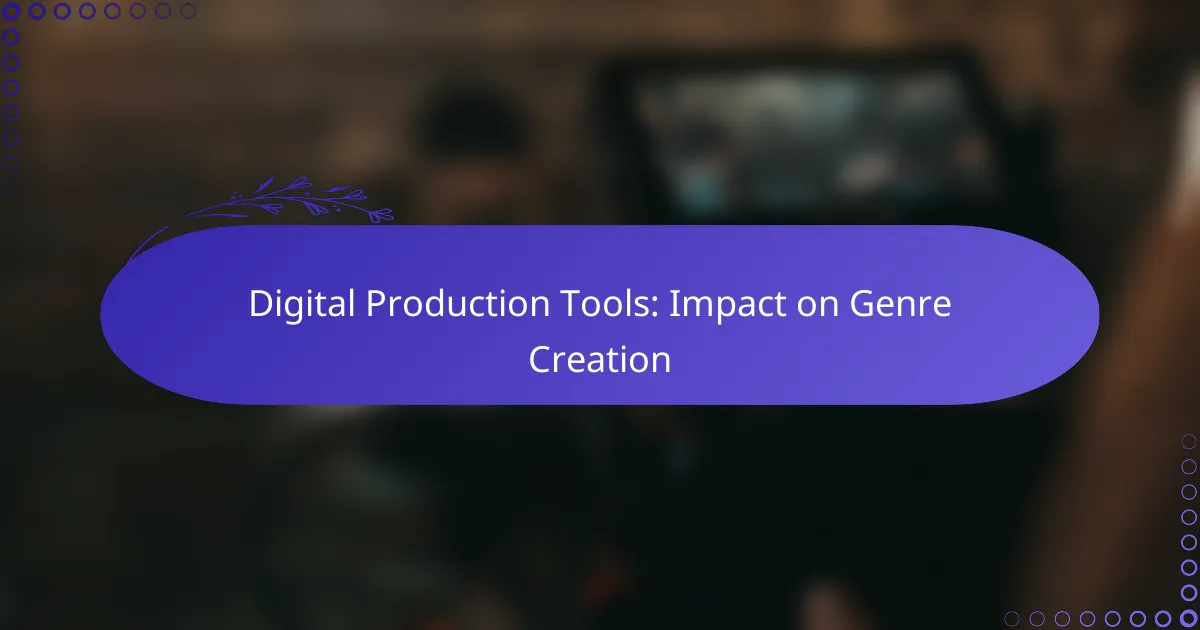Digital production tools have revolutionized genre creation by allowing artists to explore and combine sounds and styles that were once hard to achieve. These innovative technologies not only enhance creativity but also streamline workflows, leading to the emergence of new musical forms that reflect the diverse cultural landscapes of contemporary society.

How do digital production tools influence genre creation?
Digital production tools significantly impact genre creation by enabling artists to experiment with sounds and styles that were previously difficult to access. These tools foster innovation, allowing for the blending of genres and the emergence of new musical forms.
Enhanced collaboration among creators
Digital production tools facilitate collaboration by allowing multiple creators to work together in real-time, regardless of their physical locations. Platforms like Ableton Live and Logic Pro enable musicians and producers to share projects instantly, leading to a more dynamic creative process.
This collaborative environment encourages the sharing of ideas and techniques, which can result in the fusion of different genres. For instance, a hip-hop artist might collaborate with a classical musician, creating a unique blend that draws from both backgrounds.
Access to diverse sound libraries
With digital production tools, creators have access to extensive sound libraries that offer a wide range of samples and instruments. This access allows musicians to incorporate sounds from various genres, enriching their compositions and expanding their creative horizons.
For example, a producer can easily integrate traditional instruments from world music into a pop track, resulting in a fresh sound that appeals to a broader audience. Subscription services like Splice provide thousands of samples, making it easier for artists to experiment without significant financial investment.
Facilitation of genre-blending
Digital production tools enable genre-blending by allowing artists to combine elements from different musical styles seamlessly. This capability encourages experimentation, leading to the creation of hybrid genres that reflect contemporary musical trends.
For instance, the rise of genres like trap and lo-fi hip-hop showcases how artists can merge electronic beats with traditional instrumentation. By using software like FL Studio or Pro Tools, creators can manipulate sounds and structures to invent new genres that resonate with diverse audiences.

What are the key digital production tools shaping genres?
Key digital production tools significantly influence genre creation by providing innovative capabilities that enhance creativity and streamline workflows. These tools enable artists to experiment with sounds, edit content efficiently, and produce high-quality work that defines and evolves musical and visual genres.
Ableton Live for electronic music
Ableton Live is a powerful digital audio workstation (DAW) specifically designed for electronic music production. Its unique session view allows musicians to experiment with loops and samples in real-time, making it ideal for live performances and studio work alike.
When using Ableton Live, consider its extensive library of built-in instruments and effects, which can help shape your sound. Many artists appreciate the flexibility it offers, allowing for quick adjustments and creative exploration without interrupting the flow of ideas.
To maximize your experience, familiarize yourself with its MIDI capabilities and automation features. Avoid overloading your project with too many effects, as this can lead to a cluttered mix. Instead, focus on a few key elements that define your genre.
Pro Tools for audio engineering
Pro Tools is the industry standard for audio engineering, widely used in professional studios for recording, editing, and mixing. Its robust features support high track counts and complex sessions, making it suitable for various genres, from rock to orchestral music.
One of Pro Tools’ strengths is its advanced editing capabilities, allowing precise manipulation of audio clips. This is particularly useful for genres that require meticulous sound design and intricate arrangements. Additionally, its compatibility with various plugins expands creative possibilities.
When working in Pro Tools, ensure you have a solid understanding of signal flow and routing. Avoid common pitfalls like not using proper gain staging, which can lead to distortion or noise in your final mix. Regularly save your sessions to prevent data loss during intensive editing sessions.
Final Cut Pro for video production
Final Cut Pro is a leading video editing software that plays a crucial role in shaping visual genres, particularly in film and online content creation. Its intuitive interface and powerful editing tools allow creators to produce high-quality videos efficiently.
With features like magnetic timeline and advanced color grading, Final Cut Pro enables filmmakers to craft compelling narratives and visually stunning pieces. The software supports a variety of formats, making it versatile for different projects, from short films to documentaries.
To get the most out of Final Cut Pro, take advantage of its organizational tools, such as keywords and smart collections, to streamline your workflow. Avoid overusing transitions and effects, as this can detract from the storytelling. Instead, focus on pacing and continuity to enhance viewer engagement.

How do digital tools affect music genre evolution in urban areas?
Digital tools significantly influence music genre evolution in urban areas by enabling artists to create, share, and collaborate more easily. These technologies facilitate the blending of styles, leading to the emergence of new genres that reflect the diverse cultural landscapes of cities.
Emergence of trap music in Atlanta
Trap music originated in Atlanta, characterized by its use of hi-hats, heavy bass, and synthesizers. Digital production tools, such as software synthesizers and beat-making applications, have made it accessible for aspiring producers to create high-quality tracks without expensive studio time.
The collaborative nature of digital platforms allows artists to share their work instantly, leading to rapid genre evolution. For example, the use of social media and streaming services has helped trap artists gain visibility and influence, further shaping the genre’s sound and reach.
Growth of lo-fi hip hop in Los Angeles
Lo-fi hip hop has gained popularity in Los Angeles, known for its relaxed beats and nostalgic samples. Digital tools like audio editing software and sampling libraries enable producers to craft unique soundscapes that resonate with listeners seeking a chill atmosphere.
Platforms like YouTube and SoundCloud have played a crucial role in the genre’s growth, allowing artists to share their work with a global audience. The accessibility of these digital tools encourages experimentation, leading to a diverse range of sounds within the lo-fi hip hop genre.

What are the challenges of using digital production tools?
Using digital production tools presents several challenges, including the complexity of software and the potential for genre over-saturation. These factors can impact both the learning experience for new users and the diversity of music genres in the market.
Learning curve for new software
The learning curve for new digital production software can be steep, especially for beginners. Many programs feature extensive functionalities that require time and practice to master. Users may spend weeks or even months becoming proficient, which can be discouraging.
To ease this process, consider starting with user-friendly software that offers tutorials and community support. Programs like GarageBand or FL Studio provide a more accessible entry point, allowing users to gradually explore advanced features as they gain confidence.
Over-saturation of music genres
Digital production tools have contributed to the over-saturation of music genres, as they enable anyone to create and distribute music easily. This accessibility can lead to a flood of similar-sounding tracks, making it challenging for artists to stand out in a crowded market.
To navigate this landscape, artists should focus on developing a unique sound or style that differentiates their work. Collaborating with other musicians or incorporating diverse influences can also help create a distinctive musical identity amidst the genre overload.

How to choose the right digital production tool for genre creation?
Choosing the right digital production tool for genre creation involves evaluating your specific needs, workflow, and the features of the software. Consider factors such as user interface, compatibility with your existing hardware, and the tool’s ability to support your creative vision.
Assessing user interface and experience
The user interface (UI) and overall experience of a digital production tool are crucial for effective genre creation. A well-designed UI enhances creativity by allowing intuitive navigation and quick access to essential features. Look for tools that offer customizable layouts, clear visual feedback, and an organized workflow.
When assessing UI, consider testing free trials or demos to gauge how comfortable you feel while using the software. Pay attention to how easily you can perform tasks like layering sounds, editing tracks, or applying effects. A tool that feels cumbersome can hinder your creative process.
Evaluating compatibility with existing hardware
Compatibility with your existing hardware is a vital factor when selecting a digital production tool. Ensure that the software can run smoothly on your computer or device, taking into account the operating system and hardware specifications. Check for minimum and recommended system requirements provided by the software developer.
Additionally, consider how the tool interacts with other devices, such as MIDI controllers, audio interfaces, or external plugins. Tools that integrate seamlessly with your current setup can enhance your production capabilities and streamline your workflow.

What are the future trends in digital production tools?
The future of digital production tools is shaped by advancements in technology that enhance creativity and collaboration. Key trends include the integration of artificial intelligence, the rise of cloud-based platforms, and innovations in virtual reality experiences.
Integration of AI in music production
The integration of AI in music production is transforming how artists create and produce music. AI tools can analyze vast amounts of data to suggest chord progressions, melodies, and even entire compositions, allowing musicians to explore new creative avenues.
For instance, AI-driven software can generate backing tracks or assist in mixing, saving time and effort. However, artists should be cautious about over-reliance on AI, ensuring that their unique voice and style remain central to their work.
Rise of cloud-based collaboration platforms
Cloud-based collaboration platforms are becoming essential for musicians and producers, enabling real-time collaboration regardless of location. These tools allow multiple users to work on a project simultaneously, streamlining the creative process.
Popular platforms like Soundtrap and BandLab offer features such as version control and easy sharing of audio files, which enhance teamwork. However, users should be mindful of internet connectivity issues that can disrupt workflow during collaborative sessions.
Advancements in virtual reality music experiences
Advancements in virtual reality (VR) are creating immersive music experiences that engage audiences in new ways. VR technology allows users to experience concerts and music videos in a 360-degree environment, enhancing emotional connection and engagement.
For example, platforms like Oculus Venues host live VR concerts, providing a unique alternative to traditional performances. Artists and producers should consider how to leverage VR to reach wider audiences while being aware of the technical requirements and costs associated with creating high-quality VR content.
